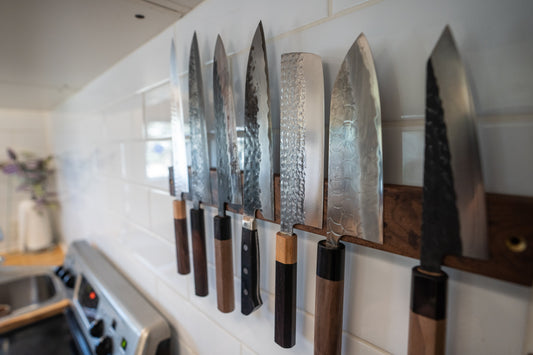Naoki Mazaki - Some of The Most Handmade Knives I've Ever Seen
When most folks think of Japanese craftsmen and artisans, they think of traditional crafts passed down through several, even dozens of generations. Honestly, that isn’t far from the truth. Many makers, like Moritaka Hamono and Masashi Yamamoto, are practicing methods that have been carefully preserved and refined over countless decades and centuries. While this has proven a pretty reliable way to preserve this art, there’s another that we’re seeing more and more often: young folks with no blacksmithing lineage to speak of, motivated purely by a love of the craft and a desire to be the best. Naoki Mazaki-san is one of the best in this new generation of knife makers.

Mazaki-san was born on the northernmost island of Japan, Hokkaido. As a young man, he was uncertain of what to do with his life. All he knew for certain was that he wanted to work with his hands, so he started a cross-country trip through Japan on his motorcycle. Stopping at town and cities along the way, he eventually stumbled across the blacksmithing scene in Sanjo, Niigata. Remember the passing down of traditional skills that I just mentioned? Sanjo is like a mecca for blacksmiths, filled to the brim with knife-making families. While many workshops continue to pass knowledge to the next generation, not every son of a blacksmith wishes to follow in his father’s footsteps. These days many break from tradition and choose different careers, so the Sanjo government has supported numerous programs to entice people from all over Japan to move to Sanjo and train under one of their master blacksmiths.
When Mazaki-san reached Sanjo, he was fascinated by the local blacksmithing culture. His mind was made up then and there; he was going to become a knifemaker. He immediately sought out a workshop that would accept him and luckily, Tsuneo Yoshida-san of Yoshikane Hamono opened his door to the young wanderer. He trained under the legendary Yoshida-san from 2011 to 2017 to build a solid foundation of skills, finally settling down in Sanjo for good and starting a workshop of his own. He is one of the first, if not the first, to start his own knifemaking workshop in the area who is neither from a blacksmithing family nor from Sanjo. We love to see young hotshots shaking things up, they often change the industry in exciting and unexpected ways.
In an era where many makers are finding the most efficient way to produce a knife and doing more work, including forging, by machine, Mazaki-san has chosen to do it the hard way. He does as much of the knife-making process by hand, entirely on his own. He forges by springhammer, rather than using an automated machine, and even forge-welds a lot of his steel himself. In plain terms, he’s the baker making the sourdough from scratch rather than using instant yeast. When it comes to sharpening, he’s even more hands-on.
Like any sane blacksmith, he uses a huge grinding wheel to grind primary bevels into his raw, freshly-forged blades. After this first grinding step, most makers proceed onto finer wheels and polishing machines, eventually sand-blasting or acid-etching the blade to make the finish pop and hide any subtle imperfections. It’s an excellent way to make a very high-performance knife, but it simply isn’t good enough for Mazaki-san. After that first large grinding wheel, he’s left with a very rough bevel full of imperfections, and rather than make things easy on himself, he sits down at his whetstone sharpening station and gets to work.
 This tiny, dimly lit corner of his workshop is where Mazaki-san perfects his masterpieces.
This tiny, dimly lit corner of his workshop is where Mazaki-san perfects his masterpieces.
Compared to industrial sharpening machines, whetstones grind steel at a snail’s pace. Masaki-san patiently shapes and polishes each and every bevel by hand, on his own, using nothing but whetstones. He doesn’t stop until each blade is absolutely perfect. Rather than grinding and polishing taking a matter of minutes per knife, Mazaki-san spends 45 minutes to an hour on every. Single. Knife. A batch of blades that would take most makers 3 days takes him a little over two weeks. I want to shake him and tell him it could be so much easier, except that I know he’s right. He sharpens this way because he knows it’s better; not better for him, but for you.
When you, or the staff at Knifewear, sharpen your Mazaki knife, the whole bevel needs to be sharpened in order to keep it thin, so it always cuts like new. Typically when I place a knife on a whetstone for its first thinning, the stone reveals all kinds of high and low spots; imperfections in the bevel. This is pretty normal, but it takes a lot of time and grinding to make the bevel perfect, so we typically let these imperfections work themselves out over the course of several sharpenings so we don’t need to grind too much steel. Your Mazaki knife is perfect out of the box, meaning it’ll be perfect after every sharpening too.
Alright, so that’s a lot of technical blabbing that knife nerds like me care about, but probably doesn’t matter much to the average person. So why do you want this knife? Just look at it! Their rustic charm betrays just how much goes into perfecting them. The burned kurouchi finish on the blade is just stunning. They’re far from light, but they also don’t feel like a hammer when you cut with them. The blades are thicker at the heel, making the back end more of a workhorse, but they taper down to a pretty thin tip. This allows for some serious precision without being too delicate. They’re gorgeous to look at, and they cut super well.

One word of warning: these blades are made from high-carbon steel. Basically, they can rust, but they cut like crazy and keep an edge super well as a result. To avoid rust, simply wipe them dry before setting them down, then hand wash and dry as soon as you’re finished chopping. Blades like Mazaki-san’s are exactly why I fell in love with Japanese knives in the first place. Every time I think about my knife I want to go make dinner. Even 15 years later, I’m still pumped to go home and cook at the end of a long day
Just as he did in his youth, Naoki Mazaki-san still loves motorcycles and on his days off he rides around on his ‘79 Harley that he fixes up himself. It’s hard to say exactly where his career will take him, but with a serious set of skills under his belt, recent forays into crafting honyaki blades, and decades of blacksmithing ahead of him, the future is bright.








